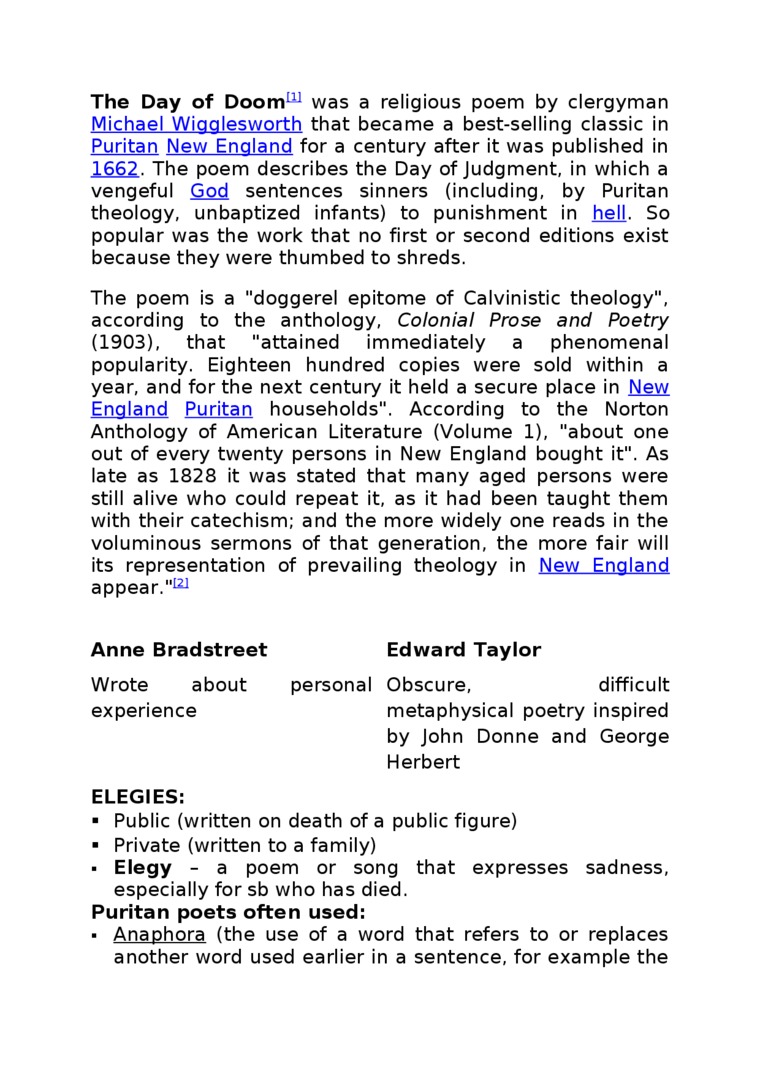107809

The Day of Doomm was a religious poem by clergyman Michael Wiaalesworth that became a best-selling classic in Puritan New Enaland for a century after it was published in 1662. The poem describes the Day of Judgment, in which a vengeful God sentences sinners (including, by Puritan theology, unbaptized infants) to punishment in heli. So popular was the work that no first or second editions exist because they were thumbed to shreds.
The poem is a "doggerel epitome of Calvinistic theology", according to the anthology, Colonial Prose and Poetry (1903), that "attained immediately a phenomenal popularity. Eighteen hundred copies were sold within a year, and for the next century it held a secure place in New Enaland Puritan households". According to the Norton Anthology of American Literaturę (Volume 1), "about one out of every twenty persons in New England bought it". As late as 1828 it was stated that many aged persons were still alive who could repeat it, as it had been taught them with their catechism; and the morę widely one reads in the voluminous sermons of that generation, the morę fair will its representation of prevailing theology in New Enaland appear."m
Annę Bradstreet Edward Taylor
Wrote about personal Obscure, difficult
experience metaphysical poetry inspired
by John Donnę and George Herbert
ELEGIES:
■ Public (written on death of a public figurę)
■ Private (written to a family)
■ Elegy - a poem or song that expresses sadness, especially for sb who has died.
Puritan poets often used:
■ Anaohora (the use of a word that refers to or replaces another word used earlier in a sentence, for example the
Wyszukiwarka
Podobne podstrony:
m853 service was assessed in rough units of five or ten ‘knights’. The amount of service was fixed b
3 The Phanariots” in Romanian Textbooks 43 3a. The image of Phanariots was created by two eleme
Obraz (7) Military services kill the residents of Groźny The resident of Groźny was killed by the ar
zyberk0002 DAWKINS: tasks 1. How does Dawkins twist the statement .. the creation of life was God’s
r r bcforc dclivery was considered a sign of pregnancy-induced hypcrlcnsion (25). The (engih of gest
PPTP When defining the PPTP server s IP rangę, avoid overlap with the rangę of IP addresses handed o
reduced to a minimum, the number of inscriptions was still too great to allow the map to serve pract
m136( The Castello Estense in the centre of Ferrara was built in 1383. Being sited on fiat, low-lyin
The following presentation is going to concentrate mainly on the issue of defining what is meant by
166. The using of complementary and alternative medicine by patients suffering fro
44 A. Doskocz, W. Dąbrowski Table 1. The accuracy of digital map data produced by different
Department and Clinic of Surgery Decreasing the number of Department was inforced according to the s
* BOOKS AND PAMPHLETS The Theory of continuous structures and arches, by Charles M. Spofford. New Yo
LJIISI S? S3 S4 W i $3 S4 The beginning of segment are morę protected by
więcej podobnych podstron